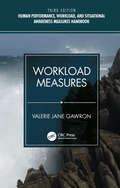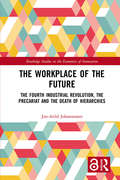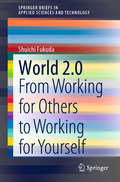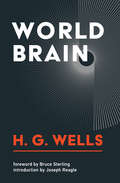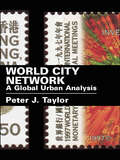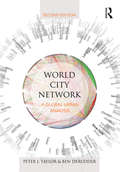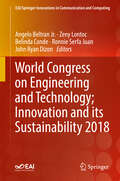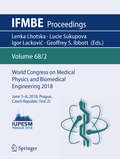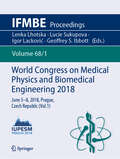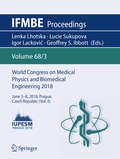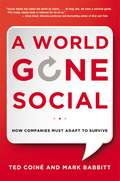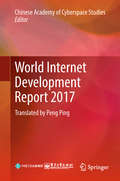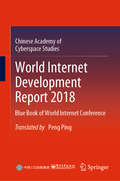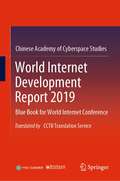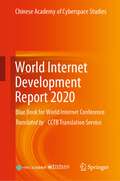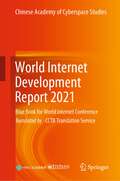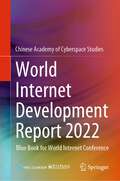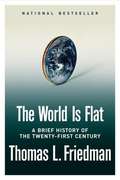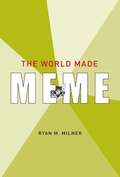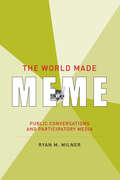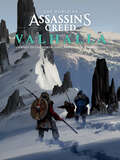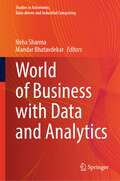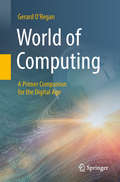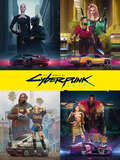- Table View
- List View
Workload Measures
by Valerie Jane GawronThis book was developed to help researchers and practitioners select measures to be used in the evaluation of human/machine systems. The book includes definitions of human workload and a review of measures. Each measure is described, along with its strengths and limitations, data requirements, threshold values, and sources of further information. To make this reference easier to use, extensive author and subject indices are provided. Features Offers readily accessible information on workload measures Presents general description of the measure Covers data collection, reduction, and analysis requirements Details the strengths and limitations or restrictions of each measure, including proprietary rights or restrictions Provides validity and reliability data as available
Workload Modeling for Computer Systems Performance Evaluation
by Dror G. FeitelsonReliable performance evaluations require the use of representative workloads. This is no easy task since modern computer systems and their workloads are complex, with many interrelated attributes and complicated structures. Experts often use sophisticated mathematics to analyze and describe workload models, making these models difficult for practitioners to grasp. This book aims to close this gap by emphasizing the intuition and the reasoning behind the definitions and derivations related to the workload models. It provides numerous examples from real production systems, with hundreds of graphs. Using this book, readers will be able to analyze collected workload data and clean it if necessary, derive statistical models that include skewed marginal distributions and correlations, and consider the need for generative models and feedback from the system. The descriptive statistics techniques covered are also useful for other domains.
The Workplace of the Future: The Fourth Industrial Revolution, the Precariat and the Death of Hierarchies (Routledge Studies in the Economics of Innovation)
by Jon-Arild JohannessenThe Fourth Industrial Revolution is a global development that shows no signs of slowing down. In his book, The Workplace of the Future: The Fourth Industrial Revolution, the Precariat and the Death of Hierarchies, Jon-Arild Johannessen sets a chilling vision of how robots and artificial intelligence will completely disrupt and transform working life. The author contests that once the dust has settled from the Fourth Industrial Revolution, workplaces and professions will be unrecognizable and we will see the rise of a new social class: the precariat. We will live side by side with the 'working poor' – people who have several jobs, but still can’t make ends meet. There will be a small salaried elite consisting of innovation and knowledge workers. Slightly further into the future, there will be a major transformation in professional environments. Johannessen also presents a typology for the precariat, the uncertain work that is created and develops a framework for the working poor, as well as for future innovation and knowledge workers, and sets out a new structure for the social hierarchy. A fascinating and thought-provoking insight into the impact of the Fourth Industrial Revolution, The Workplace of the Future will be of interest to professionals and academics alike. The book is particularly suited to academic courses in management, economy, political science and social sciences.
World 2.0: From Working for Others to Working for Yourself (SpringerBriefs in Applied Sciences and Technology)
by Shuichi FukudaThis book explores on how the Internet of Things (IoT) will change society by bringing living and non-living things together. The IoT is currently attracting considerable attention, but most of the discussions focus on engineering aspects alone. The IoT, however, is not an extension of traditional engineering, where humans and machines are separated. Instead it connects humans and machines, enabling them to work together as a team: the IoT Connected Society.In traditional engineering, our knowledge and experience of physical and non-living things plays a key role, but such knowledge and experience alone are not enough. We need to introduce life science approaches and integrate them into physical science to really develop the IoT connected society.In addition, the Internet is not only a tool for delivering messages: it is a broader communication tool. In the IoT connected society, living things and non-living things communicate in complex ways. Machines 1. Introduction2. Emerging Industrial Revolution3. IoT: What makes it different from the past revolutions4. World is changing5. Engineering: How It was developed so far6. Humans: Their characteristics7. Value is changing8. Adaptive team organization and management9. Integration of Physical Science and Life Science10. Summary can provide humans with a improved situational awareness and advice, and together they can communicate to develop a better, happier society. Thus, this book makes the case that to make the IoT connected society a reality, we need to integrate the physical and life sciences and develop a new science for the next generation of engineering.
World Brain
by H.G. WellsIn 1937, H. G. Wells proposed a predigital, freely available World Encyclopedia to represent a civilization-saving World Brain.In a series of talks and essays in 1937, H. G. Wells proselytized for what he called a "World Brain," as manifested in a World Encyclopedia--a repository of scientifically established knowledge--that would spread enlightenment around the world and lead to world peace. Wells, known to readers today as the author of The War of the Worlds and other science fiction classics, was imagining something like a predigital Wikipedia. The World Encyclopedia would provide a summary of verified reality (in about forty volumes); it would be widely available, free of copyright, and utilize the latest technology. Of course, as Bruce Sterling points out in the foreword to this edition of Wells's work, the World Brain didn't happen; the internet did. And yet, Wells anticipated aspects of the internet, envisioning the World Brain as a technical system of networked knowledge (in Sterling's words, a "hypothetical super-gadget"). Wells's optimism about the power of information might strike readers today as naïvely utopian, but possibly also inspirational.
World City Network: A Global Urban Analysis
by Peter J. Taylor Ben DerudderWith the advent of multinational corporations, the traditional urban service function has 'gone global'. In order to provide services to globalizing corporate clients, the offices of major financial and business service firms across the world have formed a network. It is the myriad of flows between office towers in different metropolitan centres that has produced a world city network. Through an analysis of the intra-company flows of 100 leading global service firms across 315 cities, this book assesses cities in terms of their overall network connectivity, their connectivity by service sector, and their connectivity by world region. Peter Taylor's unique and illuminating book provides the first comprehensive and systematic description and analysis of the world city network as the 'skeleton' upon which contemporary globalization has been built. His analyses challenge the traditional view of the world as a 'mosaic map' of political boundaries. Written by one of the foremost authorities on the subject, this book provides a much needed mapping of the connecting relationships between world cities, and will be an enlightening book for students of urban studies, geography, sociology and planning.
World City Network: A global urban analysis
by Peter J. Taylor Ben DerudderWith the advent of multinational corporations, the traditional urban service function has 'gone global'. In order to provide services to globalizing corporate clients, the offices of major financial and business service firms across the world have generated networks of work. It is the myriad of flows between office towers in different metropolitan centres that has produced a world city network. Taylor and Derudder's unique and illuminating book provides both an update and a substantial revision of the first edition that was published in 2004. It provides a comprehensive and systematic description and analysis of the world city network as the 'skeleton' upon which contemporary globalization has been built. Through an analysis of the intra-company flows of 175 leading global service firms across 526 cities in 2012, this book assesses cities in terms of their overall network connectivity, the regional configurations they form, and their changing position in the period 2000-12. Results are used to reflect on cities and city/state relations in the context of the global ecological and economic crisis. Written by two of the foremost authorities on the subject, this book provides a much-needed mapping of the connecting relationships between world cities, and will be a valuable resource for students of urban studies, geography, sociology and planning.
World Congress on Engineering and Technology; Innovation and its Sustainability 2018 (EAI/Springer Innovations in Communication and Computing)
by Angelo Beltran Jr. Zeny Lontoc Belinda Conde Ronnie Serfa Juan John Ryan DizonThe book presents the proceedings of the World Congress on Engineering and Technology, Innovation and its Sustainability (WCETIS 2018), which took place on November 28-29, 2018 in Manila, Philippines. The conference featured the following tracks: Industrial Engineering and Healthcare, Sustainable Infrastructure; Water Resources Planning and Management; Heat transfer and fluids; Electronics and Electrical Engineering; and Internet of Things. Papers stem from academia and industry throughout the world, showing a variety of perspectives.Presents the proceedings of the World Congress on Engineering and Technology, Innovation and its Sustainability (WCETIS 2018), November 28-29, 2018 in Manila, PhilippinesShows how engineering and technology serve to support a variety for industries from manufacturing to water resourcesFeatures papers from a variety of researchers and developers from around the world
World Congress on Medical Physics and Biomedical Engineering 2018: June 3-8, 2018, Prague, Czech Republic (vol. 2) (IFMBE Proceedings #68/2)
by Geoffrey S. Ibbott Lenka Lhotska Lucie Sukupova Igor LackovićThis book (vol. 2) presents the proceedings of the IUPESM World Congress on Biomedical Engineering and Medical Physics, a triennially organized joint meeting of medical physicists, biomedical engineers and adjoining health care professionals. Besides the purely scientific and technological topics, the 2018 Congress will also focus on other aspects of professional involvement in health care, such as education and training, accreditation and certification, health technology assessment and patient safety. The IUPESM meeting is an important forum for medical physicists and biomedical engineers in medicine and healthcare learn and share knowledge, and discuss the latest research outcomes and technological advancements as well as new ideas in both medical physics and biomedical engineering field.
World Congress on Medical Physics and Biomedical Engineering 2018: June 3-8, 2018, Prague, Czech Republic (vol. 2) (IFMBE Proceedings #68/2)
by Geoffrey S. Ibbott Lenka Lhotska Lucie Sukupova Igor LackovićThis book (vol. 1) presents the proceedings of the IUPESM World Congress on Biomedical Engineering and Medical Physics, a triennially organized joint meeting of medical physicists, biomedical engineers and adjoining health care professionals. Besides the purely scientific and technological topics, the 2018 Congress will also focus on other aspects of professional involvement in health care, such as education and training, accreditation and certification, health technology assessment and patient safety. The IUPESM meeting is an important forum for medical physicists and biomedical engineers in medicine and healthcare learn and share knowledge, and discuss the latest research outcomes and technological advancements as well as new ideas in both medical physics and biomedical engineering field.
World Congress on Medical Physics and Biomedical Engineering 2018: June 3-8, 2018, Prague, Czech Republic (vol. 2) (IFMBE Proceedings #68/2)
by Lenka Lhotska Lucie Sukupova Igor Lacković Geoffrey S. IbbottThis book (vol. 3) presents the proceedings of the IUPESM World Congress on Biomedical Engineering and Medical Physics, a triennially organized joint meeting of medical physicists, biomedical engineers and adjoining health care professionals. Besides the purely scientific and technological topics, the 2018 Congress will also focus on other aspects of professional involvement in health care, such as education and training, accreditation and certification, health technology assessment and patient safety. The IUPESM meeting is an important forum for medical physicists and biomedical engineers in medicine and healthcare learn and share knowledge, and discuss the latest research outcomes and technological advancements as well as new ideas in both medical physics and biomedical engineering field.
A World Gone Social: How Companies Must Adapt to Survive
by Ted Coiné Mark BabbittThe Social Revolution's impact on the business world cannot be over-estimated. Like the meteor that likely precipitated the end of the dinosaurs, Social is the catalyst in an extinction event--and business as we know it has changed forever. A World Gone Social offers an eye-opening look at fundamental and powerful changes the social collaboration era has set in motion: Customers now have the power--just watch what happens as more realize it! With increased transparency, businesses must be more ethical--no more pretending Command-and-control leadership is now so inefficient, it is a liability Nimble and small is the new competitive advantage--few corporations are capable of the agility required by evolving marketplaces Recruiting is now a two-way proposition, with job seekers able to peer behind the corporate curtain Relationship and community-building is how customers and brand ambassadors are won--and retained Engagement--with partners, employees, and customers--is not a luxury; it is a requirement. Each chapter provides compelling stories and concrete examples of companies demonstrating enlightened business practices and doing Social right--and some that are not--and the lessons to be learned from their experiences. Finally, readers will discover how to objectively assess the fit ness of their own company's culture and social presence. . . so they may successfully transition from a 20th- to a 21st-century "social" organization.
World Internet Development Report 2017: Translated by Peng Ping
by Chinese Academy of Cyberspace StudiesAn important outcome of the Fourth World Internet Conference, this book provides a comprehensive account of the status quo and trends in global Internet development. Covering network infrastructure, information technology, digital economy, e-governance, cyber security, and international cyberspace governance, it presents the Global Internet Development Index System to assess the Internet development of various major countries and emerging economies.
World Internet Development Report 2018: Blue Book of World Internet Conference
by Chinese Academy of Cyberspace StudiesThis book is an important outcome of the Fifth World Internet Conference. It provides a comprehensive account of the new trends and highlights of global Internet development over the past year, covering network infrastructure, information technology, digital economy, world internet media, cyber security, and international cyberspace governance. This year, the book improves the Global Internet Development Index System and adds more countries into the assessed list, in order to reflect more comprehensively, objectively and accurately the general situation of the world Internet development and thus to provide reference for all countries in promoting Internet development and governance.
World Internet Development Report 2019: Blue Book for World Internet Conference, Translated by CCTB Translation Service
by Chinese Academy of Cyberspace StudiesThis book systematically reviews world Internet development over the past 50 years, and comprehensively discusses the great contributions it has made to economic and social advances. Further, it describes the development, status and trends related to the Internet in major countries around the globe in 2019, and provides an in-depth analysis of the latest conditions, dynamics and development trends in key areas, including information infrastructure, information technology, digital economy, digital government, Internet media, cyberspace security, and international cyberspace governance. Moreover, the book further modifies and enhances the Global Internet Development Index System, in order to better show the Internet development strengths and advantages in various countries, and to reflect the global development trends more comprehensively, accurately and objectively. This book reviews the significant developments and summarizes the lessons learned as well as the future challenges. From a global perspective, it offers a vision of building a community with a shared future in cyberspace based on the new concepts, new ideas and new achievements of various countries participating in cyberspace development and construction. As such it is a valuable reference resource for anyone working in Internet related fields, such as those in government departments, internet enterprises, scientific research institutions, colleges and universities wanting to fully understand world Internet development.
World Internet Development Report 2020: Blue Book for World Internet Conference
by Chinese Academy of Cyberspace StudiesThis book systematically reviews the development process of the world Internet and comprehensively reveals the great contributions of the Internet to economic development and social progress. The world today is marked by changes unseen in a century, and Internet development is facing new opportunities and challenges. In 2020, the COVID-19 epidemic broke out and spread at the global scale, which enormously impacted the global economy and society. Internet played an increasingly important role.Meanwhile, based on the development status of the global Internet, this book fully reflects the development process, status and trend of the world Internet in 2020, systematically summarizes the development status and highlights of the Internet in the major countries around the world, and makes an in-depth analysis of the new conditions, new dynamics and new trends of the development in the key Internet fields; the contents cover the information infrastructure, information technology, digital economy, digital government, internet media, network security, and international cyberspace governance, and other aspects. Moreover, this book further adjusts and enriches the development index systems of the world Internet, in the hope of better showing the development strength and development advantages of the Internet in various countries, and reflecting the overall development trend of the world Internet more comprehensively, accurately and objectively.From an objective perspective, this book collects the latest research results in the global internet field, featuring comprehensive contents and highlights; from a historical perspective, this book reviews the significant development process of the global internet, summarizes the experience and faces the future; from a global perspective, this book tries to construct the cyberspace community with a common future based on the new concepts, new ideas and new achievements of various countries in participating in cyberspace development and construction. This book provides an important reference value for employees in Internet fields, such as government departments, Internet enterprises, scientific research institutions, colleges and universities, to fully understand and master the development of the world internet.
World Internet Development Report 2021: Blue Book for World Internet Conference
by Publishing House of Electronics IndustryThis book objectively represents the status quo and trends of world Internet development in 2021, systematically summarizes Internet development in major countries and regions, and deeply analyzes new development condition and trends in key fields of Internet, in terms of eight aspects, i.e., information infrastructure, information technology, digital economy, e-government, cyber media, cybersecurity, cyber laws, and international cyberspace governance. This book maintains the index system of world Internet development, optimizes some indexes, and comprehensively evaluates Internet development in major countries and regions in the world, in order to better demonstrate the strength and characteristics of Internet development in various countries and mirror the overall trend in world Internet development in a comprehensive, accurate, and objective way.This book collects the latest research results in world Internet development. With diverse subjects and detailed discussion, this book possesses great significance for these engaged in Internet field in governmental departments, Internet enterprises, scientific research institutions, and universities, who hope to fully understand world Internet development.
World Internet Development Report 2022: Blue Book for World Internet Conference
by Publishing House of Electronics IndustryThis book objectively presents the status quo and trends of world Internet development in 2022, systematically summarises Internet development in major countries and regions, and deeply analyses new development conditions and trends in key areas of the Internet in terms of eight aspects, i.e. information infrastructure, information technology, digital economy, e-government, cybermedia, cybersecurity, cyberlaw and international cyberspace governance. This book maintains the index system of world Internet development, optimises some indexes, and comprehensively evaluates Internet development in major countries and regions of the world, in order to better show the strength and characteristics of Internet development in various countries and reflect the overall trend of world Internet development in a comprehensive, accurate and objective way.This book collects the latest research results on the world Internet development. With diverse topics and in-depth discussions, this book is of great significance to those involved in the Internet field in government departments, Internet companies, scientific research institutions and universities who hope to fully understand the world's Internet development.
The World is Flat: A Brief History of the Twenty-first Century
by Thomas L. FriedmanWhen scholars write the history of the world twenty years from now and they come to the chapter "Y2K to March 2004", what will they say was the most critical development? The attacks on the World Trade Center and the Pentagon on 9/11 and the Iraq War? Or the convergence of technology and the events that allowed India and China and so many other countries to become part of the global supply chain for services and manufacturing. And with this flattening of the globe,which requires us to run faster in order to stay in place, has the world gotten too small and too fast for human beings and their political systems to adjust in a stable manner.
The World Made Meme: Public Conversations and Participatory Media
by Ryan M. MilnerInternet memes -- digital snippets that can make a joke, make a point, or make a connection -- are now a lingua franca of online life. They are collectively created, circulated, and transformed by countless users across vast networks. Most of us have seen the cat playing the piano, Kanye interrupting, Kanye interrupting the cat playing the piano. In The World Made Meme, Ryan Milner argues that memes, and the memetic process, are shaping public conversation. It's hard to imagine a major pop cultural or political moment that doesn't generate a constellation of memetic texts. Memetic media, Milner writes, offer participation by reappropriation, balancing the familiar and the foreign as new iterations intertwine with established ideas. New commentary is crafted by the mediated circulation and transformation of old ideas. Through memetic media, small strands weave together big conversations. Milner considers the formal and social dimensions of memetic media, and outlines five basic logics that structure them: multimodality, reappropriation, resonance, collectivism, and spread. He examines how memetic media both empower and exclude during public conversations, exploring the potential for public voice despite everyday antagonisms. Milner argues that memetic media enable the participation of many voices even in the midst of persistent inequality. This new kind of participatory conversation, he contends, complicates the traditional culture industries. When age-old gatekeepers intertwine with new ways of sharing information, the relationship between collective participation and individual expression becomes ambivalent. For better or worse -- and Milner offers examples of both -- memetic media have changed the nature of public conversations.
The World Made Meme: Public Conversations and Participatory Media (The Information Society Series)
by Ryan M. MilnerHow memetic media—aggregate texts that are collectively created, circulated, and transformed—become a part of public conversations that shape broader cultural debates.Internet memes—digital snippets that can make a joke, make a point, or make a connection—are now a lingua franca of online life. They are collectively created, circulated, and transformed by countless users across vast networks. Most of us have seen the cat playing the piano, Kanye interrupting, Kanye interrupting the cat playing the piano. In The World Made Meme, Ryan Milner argues that memes, and the memetic process, are shaping public conversation. It's hard to imagine a major pop cultural or political moment that doesn't generate a constellation of memetic texts. Memetic media, Milner writes, offer participation by reappropriation, balancing the familiar and the foreign as new iterations intertwine with established ideas. New commentary is crafted by the mediated circulation and transformation of old ideas. Through memetic media, small strands weave together big conversations. Milner considers the formal and social dimensions of memetic media, and outlines five basic logics that structure them: multimodality, reappropriation, resonance, collectivism, and spread. He examines how memetic media both empower and exclude during public conversations, exploring the potential for public voice despite everyday antagonisms. Milner argues that memetic media enable the participation of many voices even in the midst of persistent inequality. This new kind of participatory conversation, he contends, complicates the traditional culture industries. When age-old gatekeepers intertwine with new ways of sharing information, the relationship between collective participation and individual expression becomes ambivalent. For better or worse—and Milner offers examples of both—memetic media have changed the nature of public conversations.
The World of Assassin's Creed Valhalla: Journey to the North--Logs and Files of a Hidden One
by Rick BarbaA full-color, oversized hardcover tome that chronicles Viking culture, history, lore, and mythology amid the action and drama of Assassin&’s Creed Valhalla.Ubisoft and Dark Horse Books present The World of Assassin's Creed Valhalla, a journal kept by Hytham himself, which allows readers to experience Assassin&’s Creed Valhalla as they've never seen before.Discover the history and culture of the Raven Clan Vikings as they struggle against the Order of the ancients. Get an in-depth view at the setting of the game with descriptions and depictions of in-game characters and locals as the Vikings move from Norway to England, Ireland, and Francia. What best-kept secrets will you uncover at Hytham&’s side?
World of Business with Data and Analytics (Studies in Autonomic, Data-driven and Industrial Computing)
by Neha Sharma Mandar BhatavdekarThis book covers research work spanning the breadth of ventures, a variety of challenges and the finest of techniques used to address data and analytics, by subject matter experts from the business world. The content of this book highlights the real-life business problems that are relevant to any industry and technology environment. This book helps us become a contributor to and accelerator of artificial intelligence, data science and analytics, deploy a structured life-cycle approach to data related issues, apply appropriate analytical tools & techniques to analyze data and deliver solutions with a difference. It also brings out the story-telling element in a compelling fashion using data and analytics. This prepares the readers to drive quantitative and qualitative outcomes and apply this mindset to various business actions in different domains such as energy, manufacturing, health care, BFSI, security, etc.
World of Computing: A Primer Companion For The Digital Age
by Gerard O'ReganThis engaging work provides a concise introduction to the exciting world of computing, encompassing the theory, technology, history, and societal impact of computer software and computing devices. Spanning topics from global conflict to home gaming, international business, and human communication, this text reviews the key concepts unpinning the technology which has shaped the modern world.Topics and features: introduces the foundations of computing, the fundamentals of algorithms, and the essential concepts from mathematics and logic used in computer science; presents a concise history of computing, discussing the historical figures who made important contributions, and the machines which formed major milestones; examines the fields of human−computer interaction, and software engineering; provides accessible introductions to the core aspects of programming languages, operating systems, and databases; describes the Internet revolution, the invention of the smartphone, and the rise of social media, as well as the Internet of Things and cryptocurrencies; explores legal and ethical aspects of computing, including issues of hacking and cybercrime, and the nature of online privacy, free speech and censorship; discusses such innovations as distributed systems, service-oriented architecture, software as a service, cloud computing, and embedded systems; includes key learning topics and review questions in every chapter, and a helpful glossary.Offering an enjoyable overview of the fascinating and broad-ranging field of computing, this easy-to-understand primer introduces the general reader to the ideas on which the digital world was built, and the historical developments that helped to form the modern age.
The World of Cyberpunk 2077
by Marcin BatyldaAn insightful, captivatingly designed, full-color book that transports readers to the futuristic megalopolis of Night City--the epicenter of the vibrant new action-RPG from CD Projekt Red.Step into the year 2077, a world dotted with dystopian metropoles where violence, oppression, and cyberware implants aren't just common--they're necessary tools to get ahead. Delve into incisive lore to discover how the economic decline of the United States created a crippling dependence on devious corporations and birthed the Free State of California. Explore the various districts, gangs, and history of Night City. Learn all there is to know about the technology of tomorrow and research the cybernetics, weapons, and vehicles of Cyberpunk 2077. Dark Horse Books and CD Projekt Red present The World of Cyberpunk 2077--an extensive examination of the rich lore of Cyberpunk 2077. This intricately assembled tome contains everything you need to know about the history, characters, and world of the long-awaited follow-up from the creators of The Witcher video game series.
